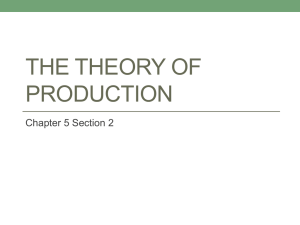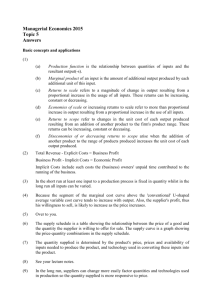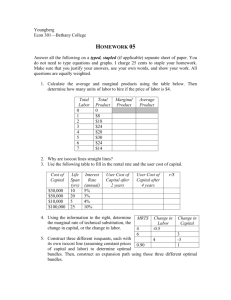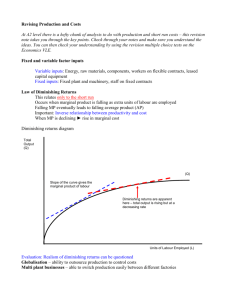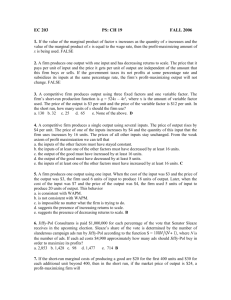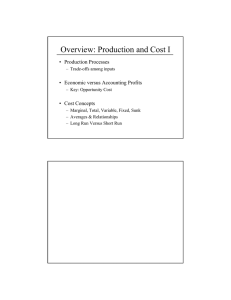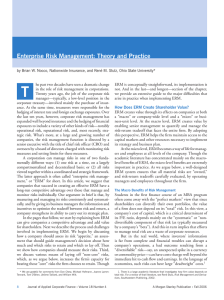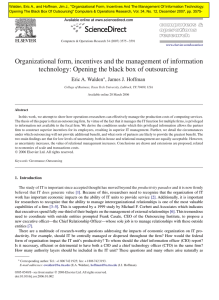Production 1. The Technology of Production The Technology of Production
advertisement
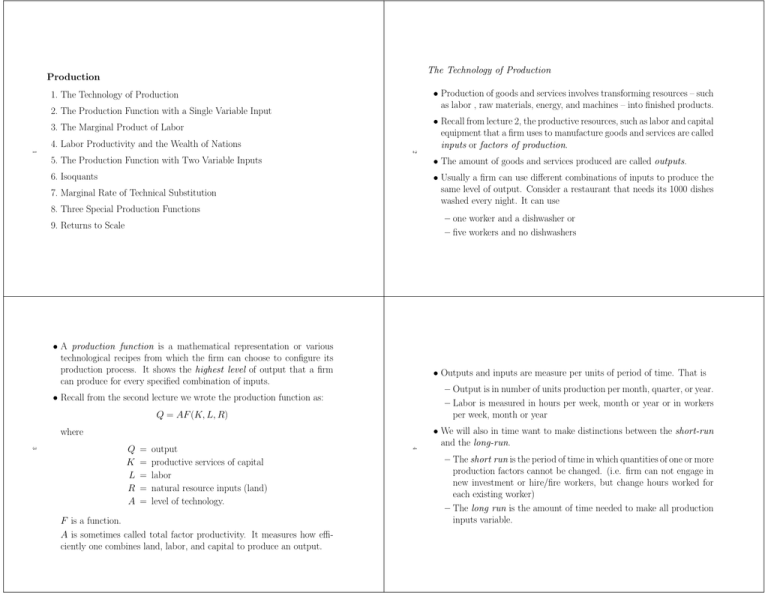
The Technology of Production Production • Production of goods and services involves transforming resources – such as labor , raw materials, energy, and machines – into finished products. 1. The Technology of Production 2. The Production Function with a Single Variable Input • Recall from lecture 2, the productive resources, such as labor and capital equipment that a firm uses to manufacture goods and services are called inputs or factors of production. 3. The Marginal Product of Labor 4. Labor Productivity and the Wealth of Nations 2 1 5. The Production Function with Two Variable Inputs • The amount of goods and services produced are called outputs. 6. Isoquants • Usually a firm can use different combinations of inputs to produce the same level of output. Consider a restaurant that needs its 1000 dishes washed every night. It can use 7. Marginal Rate of Technical Substitution 8. Three Special Production Functions – one worker and a dishwasher or – five workers and no dishwashers 9. Returns to Scale • A production function is a mathematical representation or various technological recipes from which the firm can choose to configure its production process. It shows the highest level of output that a firm can produce for every specified combination of inputs. • Outputs and inputs are measure per units of period of time. That is – Output is in number of units production per month, quarter, or year. – Labor is measured in hours per week, month or year or in workers per week, month or year • Recall from the second lecture we wrote the production function as: Q = AF (K, L, R) where = = = = = output productive services of capital labor natural resource inputs (land) level of technology. F is a function. A is sometimes called total factor productivity. It measures how efficiently one combines land, labor, and capital to produce an output. 4 3 Q K L R A • We will also in time want to make distinctions between the short-run and the long-run. – The short run is the period of time in which quantities of one or more production factors cannot be changed. (i.e. firm can not engage in new investment or hire/fire workers, but change hours worked for each existing worker) – The long run is the amount of time needed to make all production inputs variable. • Fix capital at K and increase hours. In general output is increasing in hours worked until labor hits 7 hours. Then things output peaks and even declines. • As output rises from a low level, a firm is capable of engaging in specialization and division of labor, which lead to more output increasing at an increasing rate. At higher levels of output this effect goes away and production is increasing as labor increases but at a decreasing rate. • Let’s also define: A fixed input as a production factor that cannot be varied. • Let’s make our life easier for now by assuming A = 1, so we can ignore it; let’s fix capital and land for now too. 6 5 • We are just going to look at how the maximum of amount of output a firm can produce depends on just one input: labor. • Figure 6.1. q = F (L) • Average product of labor (APL) output q APL = = labor input L The APL measures the productivity of the workforce on average. • Table 6.1 • Marginal product of labor (MPL) MPL = ∆q change in output = change in labor input ∆L The MPL measure the productivity of the last incremental increase in labor. The Marginal Product of Labor • We usually find that the marginal product of labor faces the law of diminishing marginal returns. • The average product of labor at a point A on the production function is the slope of the ray coming out of the origin and intersecting the production function at point A. • This “law” states that as the use of an input increases holding all other inputs fixed, the resulting additions to output will eventually decrease. • The marginal product of labor at point A is the slope of the production at that point. 8 7 • When M P L > AP L APL is decreasing M P L < AP L APL is decreasing • When • In other words, as you increase the labor input, output increases, but at a decreasing rate. • This is not to say that output is decreasing; just that each incremental addition of labor produces less output than the previous incremental addition. • Mathematically, the curve is concave. • At some point, the firm may face diminishing total returns to labor – that is the region along the production function where output decreases with additional labor. Malthus and the Dismal Science • The idea of diminishing returns first became influential with Thomas Malthus in 1789 with his book An Essay on the Principle of Population. • Led historian Thomas Carlyle to dub economics “the dismal science” • Fortunately Malthus was wrong 10 9 • Malthus argued as the population grew and the land area remained fixed, a society would find it increasingly difficult to grow enough food. Though more intensive cultivation of the land could increase yields, each successive farmer would add less to the total than the last as the marginal product of labor declined. Eventually per capita food production would decline as the population grew. • Conclusion: Misery was the normal condition for humankind. – Image a country in which land was abundant and population low, so that everyone had plenty to eat. Then families would be large and the population would grow rapidly – until the pressure of population on the land had reduced the condition of most people to the level where starvation and disease held the population in check – First, while 18th century European peasants did not live much better than ancient Egyptian peasants, scientific and technological progress has been so rapid during the last 200 years than diminishing returns have not been a problem. – Second, as countries have gotten wealthier, families have had fewer, not more, children. Labor Productivity and the Wealth of Nations • A quote from Paul Krugman Productivity isn’t everything, but in the long run it is almost everything Production Function With Two Variable Inputs • This is really a macroeconomic topic, but what the heck ... Consider the following example: • Average labor productivity is closely linked to per-capita output. • Think about an economy-wide production function. • How can a country increase its’ labor productivity? – perspiration theory – increase K, work more intensely. – inspiration theory – improve technology. Combine capital and labor in ways such that you get more output from the same level of inputs. • In 2005, U.S. per capital income is $41,800. China $6,200. India is $3,400. • This is called growth theory. 12 11 • Small changes in growth rate of productivity can have big affects in the long-run. 0 6 12 L 18 24 30 0 0 0 0 0 0 0 6 0 5 15 25 30 23 12 0 15 48 81 96 75 K 18 0 25 81 137 162 127 24 0 30 96 162 192 150 Production Function 30 0 23 75 127 150 117 • We can extend the concept of marginal products to the multiple product case. output 200 150 100 50 0 30 25 change in quantity of output, Q |K is held constant change in quantity of labor L ∆Q |K is held constant = ∆L 20 MP L = 15 capital 10 5 14 0 Production Function 0 13 5 15 labor change in quantity of output, Q |L is held constant change in quantity of capital K ∆Q |L is held constant = ∆K MP K = 10 Figure 1: Production Function • Likewise the marginal product of capital (M P K) is given by 20 • The marginal product tells us the steepness of the “production hill” as we change one input holding the other constant. 25 30 • Along both the capital and labor dimensions, the firms faces diminishing marginal returns. Marginal Rate of Technical Substitution Isoquants • The marginal rate of technical substitution of labor for capital is the rate at which the quantity of capital can be reduced for every one unit increase in the quantity of labor, holding the quantity of output constant. • We want to reduce our 3-dimensional analysis down to 2 dimensions. • Just as we used indifference curve to represent given levels of utility, we can use isoquants to represent given levels of output. • It is like a topographic map. • Rule out uneconomic regions of production. • Isoquants illustrate the flexibility firms have when making production decisions. – They can substitute capital for labor and vice-versa • This is analogous to the MRS from consumer theory. 16 15 • An isoquant is a curve that shows all of the combinations of labor and capital that can produce a given level of output. • It is the slope of the isoquant at a given point. Change in the capital input Change in the labor input ∆K = − for a fixed level of q ∆L M RT S = − • We assume that there is a diminishing MRTS. – As we increase the use of one input, the productivity of an additional unit of that input falls. Three Special Production Functions • Analysis on the margin 1. Capital and Labor are Perfect Substitutes Additional output from small increase in labor = M P L × (∆L) Reduction in output from small decrease in capital = M P K × (∆K) (M P L × (∆L)) + (M P K × (∆K)) = 0 f (K, L) = (K + L)α 18 17 • When moving along an isoquant ... • Example: Consider the production function where 0 < α < 1 2. Fixed Proportions • Rearranging • Example: Consider the production function ∆K MP L =− = M RT S MP K ∆L f (K, L) = (min(K, L))α where 0 < α < 1 Returns to Scale • Returns to scale is the concept that tells us the percentage by which output will increase when all inputs are increased by a given percentage. Returns to scale = 3. Cobb-Douglas • The production function looks like f (K, L) = K L where 0 < α < 1 1−α 20 19 α %∆ (quantity of output) %∆ (quantity of all inputs) • We divide returns to scale into three groups 1. Increasing returns to scale A proportionate increase in all input quantities resulting in a greater than proportionate increase in output. 2. Constant returns to scale A proportionate increase in all input quantities resulting in the same percentage increase in output. 3. Decreasing returns to scale A proportionate increase in all input quantities resulting in a less than proportionate increase in output. • Mathematically, we want to know ... F (λK, λL) > or = or < λF (K, L) • Example: The Cobb-Douglas Production Function 21 F (2K, 2L) = = = = (2K)α(2L)1−α 2αK α21−αL1−α 2K αL1−α 2F (K, L) So the Cobb-Douglas production function exhibits constant returns to scale.

